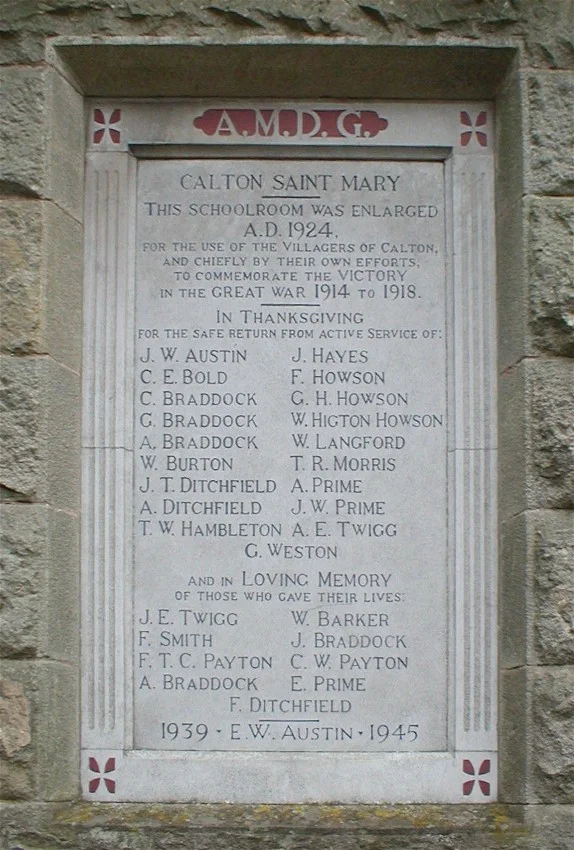- Extended Description
- This memorial is oposite the church and is on the wall of the Old School
CALTON WAR MEMORIAL
STAFFORDSHIRE
In the village of Calton, there is a memorial roll on the outside walls of the village hall which lists the 28 men who took part in WWI including the 9 men who died. Within the hall there is also a large photograph frame containing individual photo of each one of the 28 men. (Thanks David Swinscoe)
Compiled with additional information by kind permission of the Commonwealth War Graves Commission
THE CROSS IS AT THE ENTRANCE TO THE CHURCH, THE MEMORIAL IS OPPOSITE THE CHURCH ON THE WALL OF THE OLD SCHOOL, NOW THE VILLAGE HALL
IN LOVING MEMORY OF THOSE WHO GAVE THEIR LIVES
1914-1918
BARKER W Unable to find the correct one
BRADDOCK James Private 3447, 1/4th Northumberland Fusiliers died 15/09/1916. Commemorated on the Thiepval Memorial, France.
BRADDOCK Alfred Pte 2120, 19th Australian Infantry (AIF) died 8/8/1916 age 26. Son of Alfred and Ellen of Pales Farm, Calton. Buried in Boulogne Eastern Cemetery, France VIII.B.127
DITCHFIELD Frank Pte 21409, 7 The Loyal North Lancashire Regt died 5/7/1916. Commemorated on the Thiepval Memorial, Somme
PAYTON Clement Wattson Lt, 210 Sqdn, Royal Air Force. died 2/10/1918 age 21. Son of Rev Joseph Wattson Payton and Elizabeth Croydon Patyon of Westfield Bridge Road, Torquay. Native of Walsall. Holder of the D.F.C and Croix de Guerre (Belgium) and brother of Frederick who also fell. Buried in Harlebeke New British Cemetery, Belgium. II.B.6
PAYTON Frederick Thomas Croydon Cpl 6617 5th Royal Engineers, Sprcial Bde. Died 1/7/1916 age 20. Son of The Rev Joseph Wattson Payton and Elizabeth Croydon Payton of Westfield Bridge Road, Torquay. Native of Walsall. Buried in Carnoy Military Cemetery, Somme. G.30 Brother of Charles who also fell
PRIME Ernest L/Cpl 16990 2nd Lincolnshire Regt died 26/9/1915. Buried in Bailleul Communal Cemetery Extension Nord, France. II.A.23
SMITH Frederick Volume of F Smith to high to search on the CWGC
TWIGG John Ernest Pte 10661, B Coy, 1st Sherwood Foresters (Notts and Derby Regt) died 13/3/1915 age 26. Son of George & Mary Ann Twigg of Pitchings Farm, Waterfall nr Calton. Commemorated on the Le Touret Memorial, France
1939-1945
AUSTIN Eric William Sgt 1577655, 355 Sqdn, Royal Air Force died 21/6/1944 age 21. Nephew of William George and Beatrice French of Shelton Lock, Derby. Commemorated on the Singapore Memorial, Singapore












